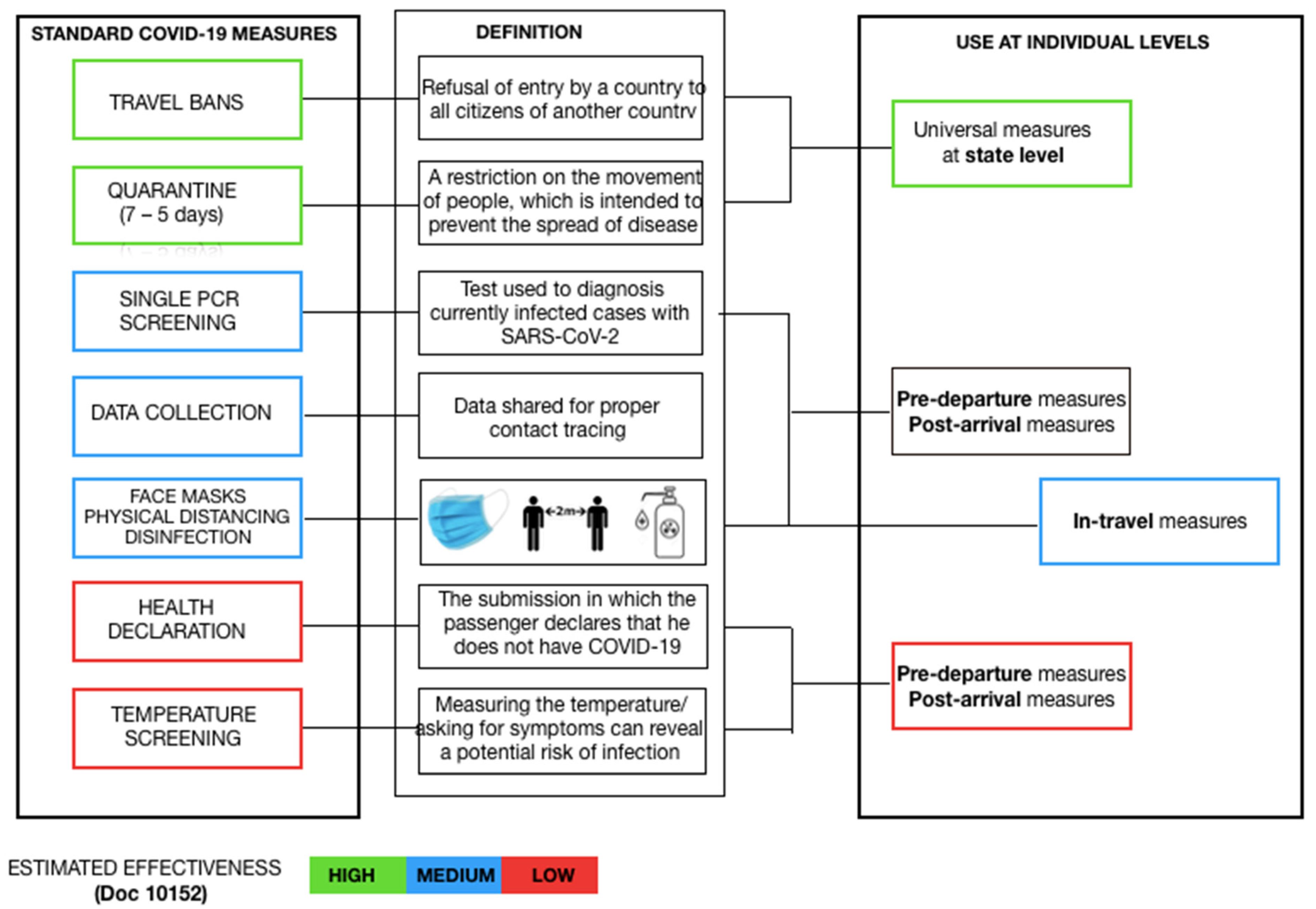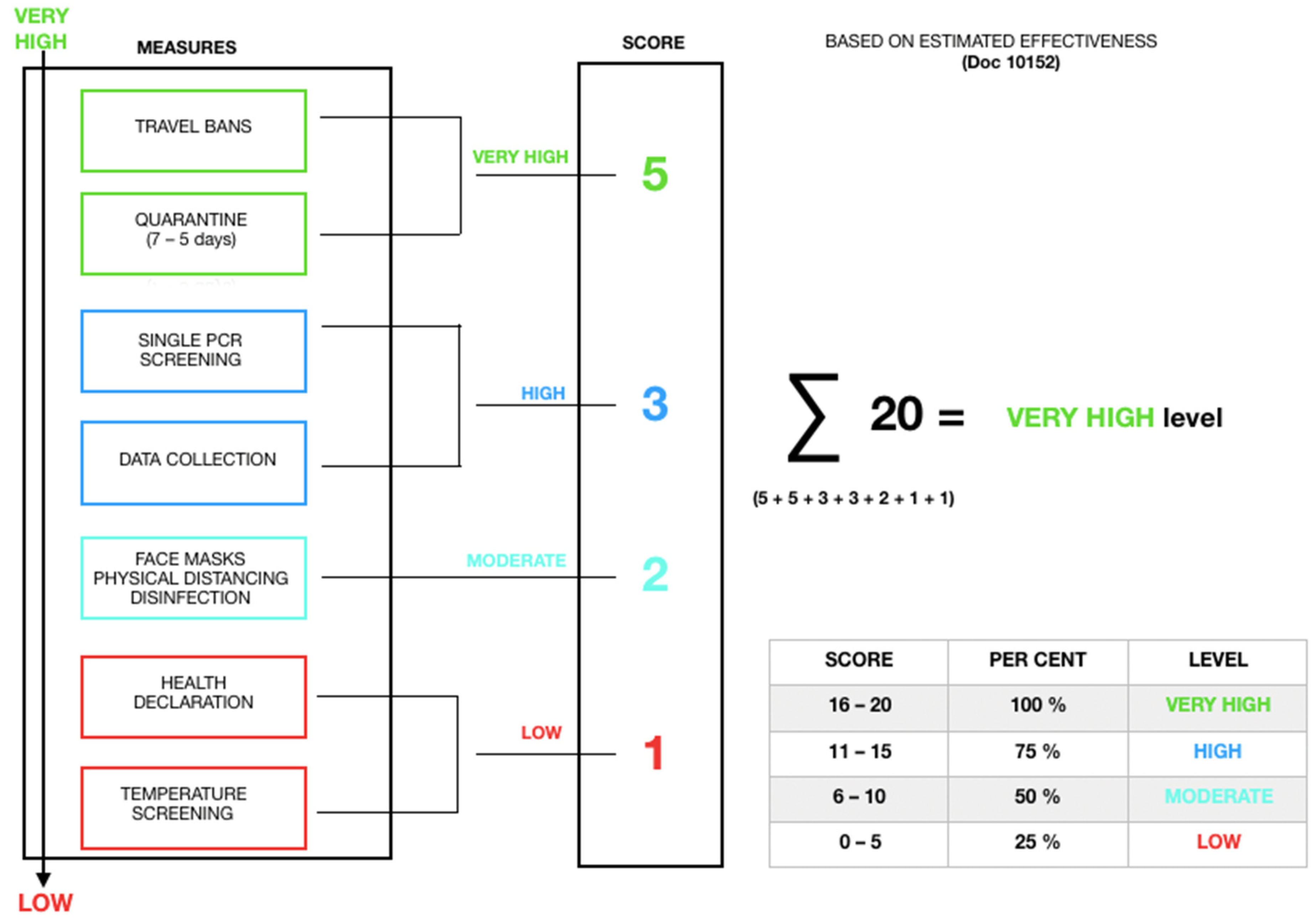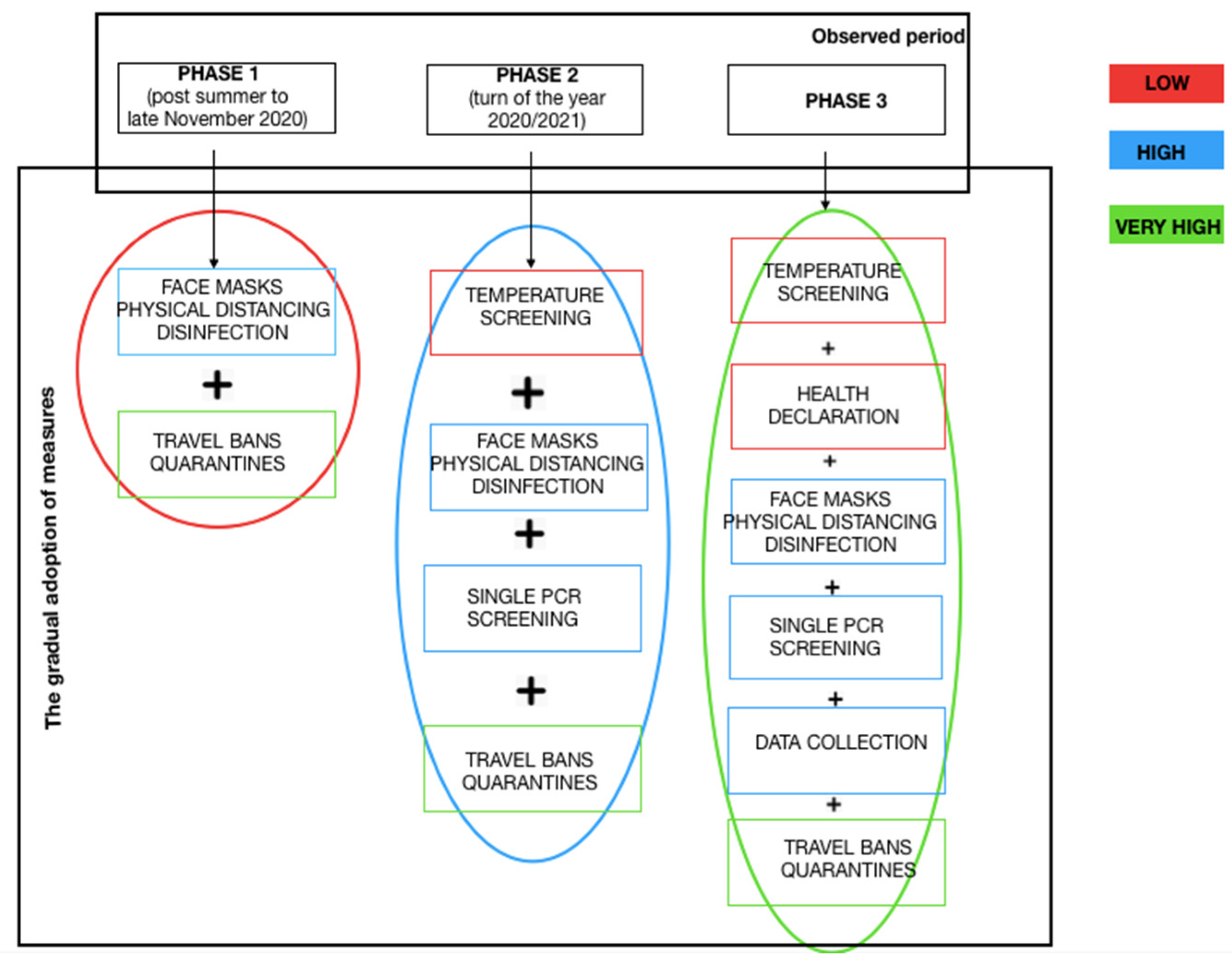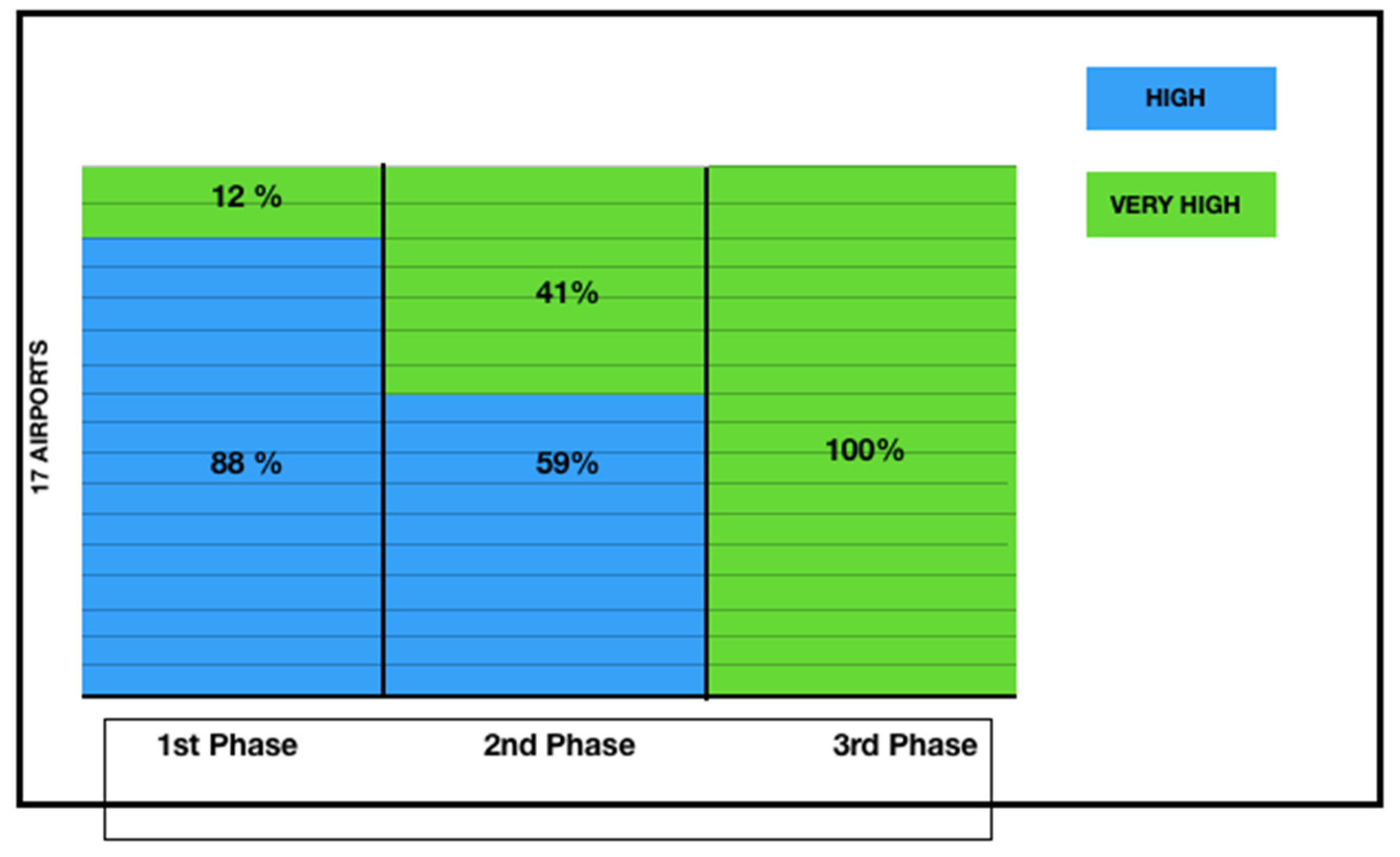Overview of Safety Measures at Selected Airports during the COVID-19 Pandemic
Abstract
:1. Introduction
2. Theoretical Background
3. Methodology
- Starting point (phase one): post-summer to late November 2020;
- Phase two: turn of the year 2020/2021;
- Phase three: acquisition of standard measures and final scoring.
4. Results
5. Conclusions
Author Contributions
Funding
Institutional Review Board Statement
Informed Consent Statement
Data Availability Statement
Conflicts of Interest
Abbreviations
| RT-PCR | Reverse transcription polymerase chain reaction |
| COVID-19 | Coronavirus disease 2019 |
| SARS-CoV-2 | Severe acute respiratory syndrome coronavirus 2 |
| WHO | World Health Organization |
| ICAO | International Civil Aviation Organization |
| CAAs | Civil Aviation Authorities |
| CART | Council’s Aviation Recovery Task Force |
| IATA | International Air Transport Association |
| ACI | Airports Council International |
| UK | United Kingdom |
| LHR | London Heathrow |
| CDG | Paris Charles de Gaulle airport |
| FRA | Frankfurt am Main Airport |
| MAD | Madrid–Barajas Airport |
| MUC | Munich Airport |
| FCO | Fiumicino International Airport |
| DUB | Dublin Airport |
| VIE | Vienna Airport |
| WAW | Warsaw Chopin Airport |
| LTN | London Luton Airport |
| PRG | Václav Havel Airport Prague |
| BUD | Budapest Ferenc Liszt Inter. Airport |
| IEV | Igor Sikorsky Kyiv Inter. Airport |
| BTS | Bratislava Airport |
| KSC | Košice International Airport |
| LUZ | Lublin Airport |
| BER | Berlin Brandenburg Airport |
| USA | United States of America |
| TSA | Transport Security Administration |
References
- Huang, C.; Wang, Y.; Li, X.; Ren, L.; Zhao, J.; Hu, Y.; Zhang, L.; Fan, G.; Xu, J.; Gu, X.; et al. Clinical features of patients infected with 2019 novel coronavirus in Wuhan, China. Lancet 2020, 395, 497–506. [Google Scholar] [CrossRef] [Green Version]
- Holshue, M.L.; DeBolt, C.; Lindquist, S.; Lofy, K.H.; Wiesman, J.; Bruce, H.; Spitters, C.; Ericson, K.; Wilkerson, S.; Tural, A.; et al. First case of 2019 novel coronavirus in the United States. N. Engl. J. Med. 2020, 382, 929–936. [Google Scholar] [CrossRef]
- World Health Organization. WHO Director-General’s Opening Remarks at the Media Briefing on COVID-19. 2020. Available online: https://www.who.int/dg/speeches/detail/who-director-general-s-opening-remarks-at-the-mission-briefing-on-covid-19-13-march (accessed on 20 December 2020).
- Pombal, R.; Hosegood, I.; Powell, D. Risk of COVID-19 during air travel. JAMA Patient Page 2020, 324, 1798. [Google Scholar]
- Wölfel, R.; Corman, V.M.; Guggemos, W.; Seilmaier, M.; Zange, S.; Müller, M.A.; Niemeyer, D.; Jones, T.C.; Vollmar, P.; Rothe, C.; et al. Virological assessment of hospitalized patients with COVID-2019. Nature 2020, 581, 465–469. [Google Scholar] [CrossRef] [PubMed] [Green Version]
- Kumar, V.; Doshi, K.U.; Khan, W.H.; Rathore, A.S. COVID-19 pandemic: Mechanism, diagnosis and treatment. J. Chem. Technol. Biotechnol. 2020, 96, 299–308. [Google Scholar] [CrossRef]
- Lytras, T.; Dellis, G.; Flountzi, A.; Hatzianastasiou, S.; Nikolopoulou, G.; Tsekou, K.; Diamantis, Z.; Stathopoulou, G.; Togka, M.; Gerolymatos, G.; et al. High prevalence of SARS-CoV-2 infection in repatriation flights to Greece from three European countries. J. Travel Med. 2020, 27, taaa054. [Google Scholar] [CrossRef] [Green Version]
- Goniewicz, K.; Khorram-Manesh, A.; Hertelendy, A.J.; Goniewicz, M.; Naylor, K.; Burkle, F.M. Current response and management decisions of the European Union to the COVID-19 outbreak: A review. Sustainability 2020, 12, 3838. [Google Scholar] [CrossRef]
- Iacus, S.M.; Santamaria, C.; Sermi, F.; Spyratos, S.; Tarchi, D.; Vespe, M. Human mobility and COVID-19 initial dynamics. Nonlinear Dyn. 2020, 101, 1901–1919. [Google Scholar] [CrossRef] [PubMed]
- Iquanto, B.L. Tourist as vector: Viral mobilities of COVID-19. Dialogues Hum. Geogr. 2020, 10, 174–177. [Google Scholar] [CrossRef]
- Cartenì, A.; Francesco, D.L.; Martino, M. The role of transport accessibility within the spread of the Coronavirus pandemic in Italy. Saf. Sci. 2021, 133, 104999. [Google Scholar] [CrossRef]
- Nižetić, S. Impact of coronavirus (COVID-19) pandemic on air transport mobility, energy, and environment: A case study. Int. J. Energy Res. 2020, 44, 10953–10961. [Google Scholar] [CrossRef]
- Sun, X.; Wandelt, S.; Zhang, A. How did COVID-19 impact air transportation? A first peek through the lens of complex networks. J. Air Transp. Manag. 2020, 89, 101928. [Google Scholar] [CrossRef]
- Bushwich, S.; Lewis, T.; Montanez, A. Evaluating COVID Risk on Planes, Trains and Automobiles. Available online: https://www.scientificamerican.com/article/evaluating-covid-risk-on-planes-trains-and-automobiles2/ (accessed on 28 March 2021).
- Nakamura, H.; Managi, S. Airport risk of imporation and exportation of the COVID-19 pandemic. Transp. Policy 2020, 96, 40–47. [Google Scholar] [CrossRef]
- Daon, Y.; Thompson, N.R.; Obolski, U. Estimating COVID-19 outbreak risk through air travel. J. Travel Med. 2020, 27, taaa093. [Google Scholar] [CrossRef]
- Serrano, F.; Kazda, A. The future of airport post COVID-19. J. Air Transp. Manag. 2020, 89, 101900. [Google Scholar] [CrossRef]
- Wilder-Smith, A.; Freedman, D.O. Isolation, quarantine, social distancing and community containment: Pivotal role for old-style public health measures in the novel coronavirus (2019-nCoV) outbreak. J. Travel Med. 2020, 27, 1–4. [Google Scholar] [CrossRef]
- Güner, H.R.; Hasanoğlu, I.; Aktaş, F. COVID-19: Prevention and control measures in community. Turk. J. Med. Sci. 2020, 50, 571–577. [Google Scholar] [CrossRef] [PubMed]
- Salyer, S.J.; Maeda, J.; Sembuche, S.; Kebede, Y.; Tshangela, A.; Moussif, M.; Ihekweazu, C.; Mayet, N.; Abate, E.; Ouma, A.O.; et al. The first and second waves of the COVID-19 pandemic in Africa: A cross-sectional study. Lancet 2021, 397, 1265–1275. [Google Scholar] [CrossRef]
- Looi, M.K. Covid-19: Is a second wave hitting Europe? BMJ 2020, 371, m4113. [Google Scholar] [CrossRef]
- Bielecki, M.; Patel, D.; Hinkelbein, J.; Komorowski, M.; Kester, J.; Ebrahim, S.; Rodriguez-Morales, A.J.; Memish, Z.A.; Schlagenhauf, P. Reprint of: Air travel and COVID-19 prevention in the pandemic and peri-pandemic period: A narrative review. Travel Med. Infect. Dis. 2020, 38, 101939. [Google Scholar] [CrossRef]
- Chu, D.K.; Akl, E.A.; Duda, S.; Solo, K.; Yaacoub, S.; Schünemann, H.J.; El-harakeh, A.; Bognanni, A.; Lotfi, T.; Loeb, M.; et al. Physical distancing, face masks, and eye protection to prevent person-to-person transmission of SARS-CoV-2 and COVID-19: A systematic review and meta-analysis. Lancet 2020, 395, 1973–1987. [Google Scholar] [CrossRef]
- Xiao, Y.; Torok, M.E. Taking the right measures to control COVID-19. Lancet Infect. Dis. 2020, 20, 523–524. [Google Scholar] [CrossRef] [Green Version]
- International Civil Aviation Organization (ICAO). Doc. 10144 ICAO Handbook for CAAs on the Management of Aviation Safety Risks related to COVID-19. 2020. Available online: https://www.icao.int/safety/SafetyManagement/Doc10144/Doc%2010144.pdf (accessed on 13 January 2021).
- Fang, H.; Wang, L.; Yang, Y. Human mobility restrictions and the spread of the Novel Coronavirus (2019-nCoV) in China. J. Public Econ. 2020, 191, 104272. [Google Scholar] [CrossRef]
- Cartenì, A.; Di Francesco, L.; Martino, M. How mobility habits influenced the spread of the COVID-19 pandemic: Results from the Italian case. Sci. Total Environ. 2020, 741, 140489. [Google Scholar] [CrossRef] [PubMed]
- Hoang, A.T.; Nižetić, S.; Olcer, A.I.; Ong, H.C.; Chen, W.H.; Chong, C.T.; Thomas, S.; Bandh, S.A.; Nguyen, X.P. Impacts of COVID-19 pandemic on the global energy system and the shift progress to renewable energy: Opportunities, challenges, and policy implications. Energy Policy 2021, 154, 112322. [Google Scholar] [CrossRef]
- International Civil Aviation Organization (ICAO). Doc. 10152 ICAO Manual on Testing and Cross-Border Risk Management Measures. 2020. Available online: https://www.icao.int/safety/CAPSCA/PublishingImages/Pages/ICAO-Manuals/Doc%2010152_Unedited%20Second%20Edition_Manual%20on%20Testing%20and%20Cross-border%20Risk%20Management%20Measures.PDF (accessed on 16 January 2021).
- Clifford, S.; Quilty, B.J.; Russell, T.W.; Liu, Y.; Chan, Y.W.D.; Pearson, C.A.; Eggo, R.M.; Endo, A.; Flasche, S.; Edmunds, W.J.; et al. Strategies to reduce the risk of SARS-CoV-2 re-introduction from international traveller. medRxiv 2020. [Google Scholar] [CrossRef]
- Taylor, R.; McCarthy, C.A.; Patel, V.; Moir, R.; Kelly, L.; Snary, E. The risk of introducing SARS-CoV-2 to the UK via international travel in August 2020. medRxiv 2020. [Google Scholar] [CrossRef]
- Heathrow. Coronavirus Update. 2021. Available online: https://www.heathrow.com/customer-support/faq/coronavirus-covid-19 (accessed on 20 March 2021).
- Paris Aéroport. Covid-19: Informations aux Voyageurs. 2021. Available online: https://www.parisaeroport.fr/passagers/les-vols/covid-19-informations-voyageurs (accessed on 20 March 2021).
- Franfurt Airport. Informationen zu Covid-19. Unbesorgt Reisen ab Frankfurt Airport. 2021. Available online: https://www.frankfurt-airport.com/de/reisevorbereitung/coronavirus.html (accessed on 20 March 2021).
- Skytrax. Madrid Barajas Airport COVID-19 Rating. 2021. Available online: https://skytraxratings.com/airports/madrid-barajas-airport-covid-19-rating (accessed on 20 March 2021).
- Munich Airport. Travelling in Times of the Coronavirus Pandemic. 2021. Available online: https://www.munich-airport.com/travelling-in-times-of-the-coronavirus-pandemic-8395611 (accessed on 20 March 2021).
- Aeroporti di Roma. Covid-19. 2021. Available online: https://www.adr.it/it/web/guest/coronavirus (accessed on 20 March 2021).
- Vienna Airport. Restricted Operation at Vienna Airport. 2021. Available online: https://www.viennaairport.com/en/passengers (accessed on 2 April 2021).
- Warsaw Chopin Airport. Szybkie Testy w Kierunku COVID-19 dla Pasażerów Lotniska Chopina w Warszawie. 2021. Available online: https://lotnisko-chopina.pl/pl/aktualnosci-i-wydarzenia/0/1018/szczegoly.html (accessed on 2 April 2021).
- Dublin Airport. COVID-19 Safety Measures. 2021. Available online: https://www.dublinairport.com/covid-19/COVID19-safety-measures (accessed on 2 April 2021).
- London Luton. Safer Travel. 2021. Available online: https://www.london-luton.co.uk/safer-travel (accessed on 2 April 2021).
- Prague Airport. Current Information and Recommendation for Passengers. 2021. Available online: https://www.prg.aero/en#/ (accessed on 2 April 2021).
- Budapest Airport. Covid-19: Információ az Utasok Részére. 2021. Available online: https://www.bud.hu/covid_19 (accessed on 2 April 2021).
- Kyiv Sikorsky Airport. COVID-19 Safety Regulations. 2021. Available online: https://iev.aero/en/covid (accessed on 2 April 2021).
- Bratislava Airport. Covid-19: QandA. 2021. Available online: https://www.bts.aero/covid-19-otazky-a-odpovede/ (accessed on 2 April 2021).
- Kosice Airport. Informácie a Obmedzenia v Súvislosti s COVID-19. 2021. Available online: https://www.airportkosice.sk/sk/pre-cestujucich/aktuality/informacie-obmedzenia-v-suvislosti-s-covid-19 (accessed on 2 April 2021).
- Lublin Airport. Lublin Airport. 2021. Available online: https://www.airport.lublin.pl/en/ (accessed on 2 April 2021).
- Berlin Airport. Flying Sagely under Corona Conditions. 2021. Available online: https://ber.berlin-airport.de/en/flying/covid-19.html (accessed on 2 April 2021).
- International Civil Aviation Organization (ICAO). ICAO World Civil Aviation Report (WCAR), 4th ed.; ICAO: Montréal, QC, Canada, 2020. [Google Scholar]
- Transport Security Administration. Coronavirus (COVID-19) Information. 2021. Available online: https://www.tsa.gov/coronavirus (accessed on 20 July 2021).




| State | Iata Code | Airport | Lockdowns/Travel Bans |
|---|---|---|---|
| UK | LHR | London Heathrow | ✓ |
| France | CDG | Paris Charles de Gaulle airport | ✓ |
| Germany | FRA | Frankfurt am Main Airport | ✓ |
| Spain | MAD | Madrid–Barajas Airport | ✓ |
| Germany | MUC | Munich Airport | ✓ |
| Italy | FCO | Fiumicino International Airport | ✓ |
| Ireland | DUB | Dublin Airport | ✓ |
| Austria | VIE | Vienna International Airport | ✓ |
| Poland | WAW | Warsaw Chopin Airport | ✓ |
| UK | LTN | London Luton Airport | ✓ |
| Czech Republic | PRG | Václav Havel Airport Prague | ✓ |
| Hungary | BUD | Budapest Ferenc Liszt Inter. Airport | ✓ |
| Ukraine | IEV | Igor Sikorsky Kyiv Inter. Airport | ✓ |
| Slovakia | BTS | Bratislava Airport | ✓ |
| Slovakia | KSC | Košice International Airport | ✓ |
| Poland | LUZ | Lublin Airport | ✓ |
| Germany | BER | Berlin Brandenburg Airport | ✓ |
| Airport | Social Distance < 2 m | Face Masks | Disinfection | Temperature Check | Rt-PCR Screening | Score |
|---|---|---|---|---|---|---|
| LHR | ✓ | ✓ | ✓ | ✓ | PARTLY | 14.5 |
| CDG | 1.5.M | ✓ | ✓ | ✓ | PARTLY | 14.5 |
| FRA | 1.5.M | ✓ | ✓ | NO | ✓ | 15 |
| MAD | 1.5.M | ✓ | PARTLY | PARTLY | NO | 11.5 |
| MUC | 1.5.M | ✓ | ✓ | NO | ✓ | 15 |
| FCO | 1 M | ✓ | ✓ | ✓ | ✓ | 16 |
| DUB | ✓ | ✓ | PARTLY | PARTLY | PARTLY | 13 |
| VIE | ✓ | ✓ | ✓ | ✓ | ✓ | 16 |
| WAW | 1.5 M | ✓ | ✓ | PARTLY | NO | 12.5 |
| LTN | ✓ | ✓ | ✓ | ✓ | NO | 13 |
| PRG | ✓ | ✓ | ✓ | NO | ✓ | 15 |
| BUD | 1.5 M | PARTLY | PARTLY | PARTLY | NO | 11 |
| IEV | PARTLY | ✓ | ✓ | ✓ | ✓ | 15 |
| BTS | ✓ | ✓ | ✓ | ✓ | NO | 13 |
| KSC | ✓ | ✓ | ✓ | ✓ | NO | 13 |
| LUZ | 1.5 M | ✓ | ✓ | ✓ | NO | 13 |
| BER | ✓ | ✓ | ✓ | NO | ✓ | 15 |
| Airport | Social Distance < 2 m | Face Masks | Disinfection | Temperature Check | Rt-PCR Screening | Score |
|---|---|---|---|---|---|---|
| LHR | ✓ | ✓ | ✓ | ✓ | ✓ | 16 |
| CDG | ✓ | ✓ | ✓ | ✓ | ✓ | 16 |
| FRA | ✓ | ✓ | ✓ | NO | ✓ | 15 |
| MAD | ✓ | ✓ | ✓ | ✓ | NO | 13 |
| MUC | ✓ | ✓ | ✓ | NO | ✓ | 15 |
| FCO | 1 M | ✓ | ✓ | ✓ | ✓ | 16 |
| DUB | ✓ | ✓ | ✓ | ✓ | ✓ | 16 |
| VIE | ✓ | ✓ | ✓ | ✓ | ✓ | 16 |
| WAW | ✓ | ✓ | ✓ | ✓ | ✓ | 16 |
| LTN | ✓ | ✓ | ✓ | ✓ | NO | 13 |
| PRG | ✓ | ✓ | ✓ | NO | ✓ | 15 |
| BUD | ✓ | ✓ | ✓ | ✓ | NO | 13 |
| IEV | 1.5 M | ✓ | ✓ | ✓ | ✓ | 16 |
| BTS | ✓ | ✓ | ✓ | ✓ | NO | 13 |
| KSC | ✓ | ✓ | ✓ | ✓ | NO | 13 |
| LUZ | 1.5 M | ✓ | ✓ | ✓ | NO | 13 |
| BER | ✓ | ✓ | ✓ | NO | ✓ | 15 |
| Airport | Preliminary Score | Data Collection | Health Declaration | Total Score | Percent |
|---|---|---|---|---|---|
| LHR | 16 | ✓ | NO | 19 | 95% |
| CDG | 16 | ✓ | ✓ | 20 | 100% |
| FRA | 15 | ✓ | ✓ | 19 | 95% |
| MAD | 13 | ✓ | ✓ | 17 | 85% |
| MUC | 15 | ✓ | NO | 18 | 90% |
| FCO | 16 | ✓ | ✓ | 20 | 100% |
| DUB | 16 | ✓ | ✓ | 20 | 100% |
| VIE | 16 | ✓ | ✓ | 20 | 100% |
| WAW | 16 | ✓ | NO | 19 | 95% |
| LTN | 13 | ✓ | ✓ | 17 | 85% |
| PRG | 15 | ✓ | ✓ | 19 | 95% |
| BUD | 13 | ✓ | ✓ | 17 | 85% |
| IEV | 16 | ✓ | ✓ | 20 | 100% |
| BTS | 13 | ✓ | ✓ | 17 | 85% |
| KSC | 13 | ✓ | ✓ | 17 | 85% |
| LUZ | 13 | ✓ | ✓ | 19 | 85% |
| BER | 15 | ✓ | ✓ | 19 | 95% |
Publisher’s Note: MDPI stays neutral with regard to jurisdictional claims in published maps and institutional affiliations. |
© 2021 by the authors. Licensee MDPI, Basel, Switzerland. This article is an open access article distributed under the terms and conditions of the Creative Commons Attribution (CC BY) license (https://creativecommons.org/licenses/by/4.0/).
Share and Cite
Blišťanová, M.; Tirpáková, M.; Brůnová, Ľ. Overview of Safety Measures at Selected Airports during the COVID-19 Pandemic. Sustainability 2021, 13, 8499. https://doi.org/10.3390/su13158499
Blišťanová M, Tirpáková M, Brůnová Ľ. Overview of Safety Measures at Selected Airports during the COVID-19 Pandemic. Sustainability. 2021; 13(15):8499. https://doi.org/10.3390/su13158499
Chicago/Turabian StyleBlišťanová, Monika, Michaela Tirpáková, and Ľubomíra Brůnová. 2021. "Overview of Safety Measures at Selected Airports during the COVID-19 Pandemic" Sustainability 13, no. 15: 8499. https://doi.org/10.3390/su13158499
APA StyleBlišťanová, M., Tirpáková, M., & Brůnová, Ľ. (2021). Overview of Safety Measures at Selected Airports during the COVID-19 Pandemic. Sustainability, 13(15), 8499. https://doi.org/10.3390/su13158499






